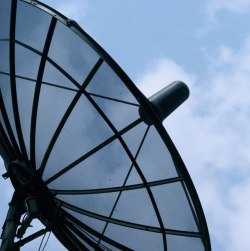 Satellite television has been around for over 50 years, and looks like it’s here to stay. Early satellite dishes were sometimes as large as a house, and required a lot of space for installation. Additionally, the signal wasn’t always very strong, and something as simple as cloud cover could disrupt the signal. Today’s satellite dishes are small and compact, and can fit easily on a rooftop, or even a pole mounted in the yard, and some are capable of receiving multiple signals from multiple satellites. Some dishes even receive and transmit high-speed internet to and from remote areas. Below is a brief history of satellite television.
Satellite television has been around for over 50 years, and looks like it’s here to stay. Early satellite dishes were sometimes as large as a house, and required a lot of space for installation. Additionally, the signal wasn’t always very strong, and something as simple as cloud cover could disrupt the signal. Today’s satellite dishes are small and compact, and can fit easily on a rooftop, or even a pole mounted in the yard, and some are capable of receiving multiple signals from multiple satellites. Some dishes even receive and transmit high-speed internet to and from remote areas. Below is a brief history of satellite television.
The Very First Satellite Broadcast
The very first satellite broadcast happened on July 23, 1962 in Europe, Canada, the US and the UK when AT&Ts Telstar satellite transmitted the first live image across the Atlantic – an image of the Statue of Liberty. That satellite image was not broadcast to personal satellite dishes, but to the major television networks.
That groundbreaking broadcast was the beginning of television networks using satellite communications to broadcast signals over a greater distance than previously imagined. It also paved the way for improved long-distance telephone communications, fax machines, ATM networks, internet communication, and bringing satellite broadcasts directly into consumers’ homes.
Early Direct to Consumer Satellite Dishes
Direct to consumer, or direct to home, satellite systems were first introduced in the 1980s in the 1980s. Early satellite dishes were primarily used in rural areas due in part to the fact that rural areas were the only places that had enough space for them, and because rural areas were often the most in need of them. It was not unusual for people in rural areas to be unable to receive broadcasts from the major networks due to lack of adequate wiring, or interference from natural structures like mountain ranges.
Early satellite dishes didn’t get the hundreds of channels that are available today, instead the broadcast the three major networks and PBS. However, cable TV was quickly growing and many of those broadcaster used satellite transmissions to broadcast their signals. Often times, consumers with satellite dishes were able to access these broadcast signals.
Broadcasters initially fought against the availability of satellite dishes because they felt that the dishes allowed people to access their broadcasts illegally. However, the FCC ruled that consumers had as much right to access those signals as the broadcasters had to transmit them. As a result, broadcasters began scrambling their channels, and consumers began buying descrambling boxes. As satellites grew in popularity, so too did the number of available channels and satellite systems soon had as many, if not more, channels as the cable packages of the time.
Satellite TV Today
Today satellite companies like DirecTV and Dish Network compete directly with the cable companies and offer the same channels. However, satellite systems often offer deals that are much cheaper than cable (you can find out more about these deals here) and often have packages that cable providers don’t have – such as the NFL Sunday Ticket.
New satellite dishes have HD capacity, and also have stronger and more stable signal capability to enhance the consumer’s viewing experience.
The original Telstar satellite was decommissioned in 1963, but subsequent satellites have been sent into orbit – each one better than the last. The original Telstar satellite is still in orbit and is a monument to human ingenuity.

